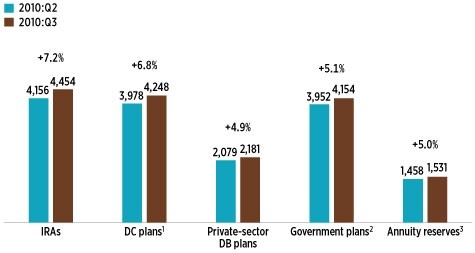ICI Viewpoints
Factors Behind Recent Growth in Retirement Assets
Last month, we published The U.S. Retirement Market: Third Quarter 2010. The report showed that U.S. retirement assets rose nearly $1 trillion, or 6.1 percent, to $16.6 trillion in the third quarter of 2010. As the chart illustrates, every major component of U.S. retirement saving saw growth, quarter over quarter. (Our chart does not include Social Security.)
All Types of Retirement Assets Grew in the Third Quarter
Billions of dollars, end-of-period, 2010:Q2–2010:Q3

1DC plans include 403(b) plans, 457 plans, and private-sector employer-sponsored DC plans (including 401(k) plans).
2Government plans include federal, and state and local pension plans. Federal pension plans include U.S. Treasury security holdings of the civil service retirement and disability fund, the military retirement fund, the judicial retirement funds, the Railroad Retirement Board, and the foreign service retirement and disability fund. These plans also include securities held in the National Railroad Retirement Investment Trust and FERS TSP.
3Annuity reserves include all fixed and variable annuity reserves at life insurance companies less annuities held by IRAs, 403(b) plans, 457 plans, and private pension funds.
Note: The IRA asset data are estimated.
Sources: Investment Company Institute, Federal Reserve Board, National Association of Government Defined Contribution Administrators, American Council of Life Insurers, and Internal Revenue Service Statistics of Income Division (See Brady, Short, Lutz, and Holden, The U.S. Retirement Market: Third Quarter 2010 (January 2011))
So what drove that growth? There were primarily two factors: market returns and net contributions. On the former, a healthy stock market had a big impact—the S&P 500 index, for example, showed a total return (capital gains plus reinvested interest and dividends) of 11.3 percent for the quarter.
As for net contributions, the picture is mixed. We define “net contribution” as contributions (from employers and employees) plus rollovers into a given type of retirement asset, less distributions (benefit payments, rollovers out of that asset type, and withdrawals).
Defined contribution (DC) plans and individual retirement accounts (IRAs) typically have net inflows. Private-sector defined benefit (DB) plans, however, have been in net outflow mode for several years, as the benefits paid exceed new contributions. Thus, growth of DB assets was muted for the third quarter.
Regarding government plans, state and local plans have had net outflows since 2009. Federal plans typically have net inflows, but a majority of the assets is invested in government bonds, which had the effect of restraining growth in this category of retirement assets for the quarter.
Sarah Holden is the Senior Director of Retirement and Investor Research at ICI.
